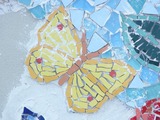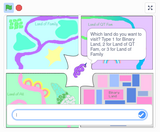
Butterfly adaptations are linked to Greek and Roman mosaics.
- Subject:
- Cross-Curricular
- Measurement and Geometry
- STEM/STEAM
- Visual Art
- Material Type:
- Lesson
- Author:
- Jamie Marquitz
- Amy Erb
- Candice Anthony-Cazenave
- Jessica Brown
- Date Added:
- 12/23/2020

Butterfly adaptations are linked to Greek and Roman mosaics.

Objectives: Students will be able to identify hidden images in visual media. Students will identify themes in images.Students will identify supportive evidence in images.Students will identify if the image is a fact or opinion, persuasive, or informational. Students will be able to identify encoded messages in visual images. Students will be able to identify a creative practice to reflect on hidden meanings in visual images.

1. Have the students bring a Math graphing problem that they have been working on in class. **This will take some coordination with their homeroom teacher in order to work! or present a simple graphing problem for them to solve. It needs to have 3-4 variables. This is so that they can use 3-4 coordinating colors of yarn for their design.In this lesson, we will translate the bar graph chart into a horizontal graph design. Use the numbers to represent rows of weaving. For example, if a 5 is represented in the information then color in a section of rows on the graph paper to represent 5 rows that will be woven in that color. Tell the students to use the same colors that they have on their math bar graph, when creating their graph for weaving so that there is less confusion.

This lesson sequence offers students and teachers a way to explore their individual identities and sense of belonging through analyzing children’s literature and coding with Scratch. Through read-aloud activities and self-differentiated Scratch projects, students learn about the value of inclusion and explore and express ideas about their personal and social identities. Students will describe environments supportive of diversity, and reflect on their own identity as they create expressive projects about their sense of belonging. This sequence is made up of four lessons, though your students may need additional class time to work on their projects.This lesson sequence is part of CodeVA's committment to the U.S. Department of Education "YOU Belong in STEM" initiative.

Students will be learning how art and engineering intersect by using Tinkercad, 3D modeling software, produced by Autodesk, to create a physical, 3d printed, product. In this Tinkercad introduction project, students will produce a text-based keychain.